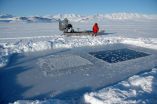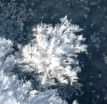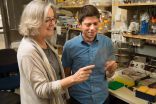(Press-News.org) Due to global warming, larger and larger areas of sea ice melt in the summer and when sea ice freezes over in the winter it is thinner and more reduced. As the Arctic summers are getting warmer we may see an acceleration of global warming, because reduced sea ice in the Arctic will remove less CO2 from the atmosphere, Danish scientists report.
"If our results are representative, then sea ice plays a greater role than expected, and we should take this into account in future global CO2 budgets", says Dorte Haubjerg Søgaard, PhD Fellow, Nordic Center for Earth Evolution, University of Southern Denmark and the Greenland Institute of Natural Resources, Nuuk.
Only recently scientists have realized that sea ice has an impact on the planet's CO2 balance.
"We have long known that the Earth's oceans are able to absorb huge amounts of CO2. But we also thought that this did not apply to ocean areas covered by ice, because the ice was considered impenetrable. However, this is not true: New research shows that sea ice in the Arctic draws large amounts of CO2 from the atmosphere into the ocean", says Dorte Haubjerg Søgaard.
Dorte Haubjerg Søgaard has just completed her studies of sea ice in Greenland. The studies show that sea ice may have a major impact on the global carbon cycle, and that chemical processes have a much greater impact on the sea ice's ability to remove CO2 than biological processes. The research is published as a series of articles in scientific journals.
"The chemical removal of CO2 in sea ice occurs in two phases. First crystals of calcium carbonate are formed in sea ice in winter. During this formation CO2 splits off and is dissolved in a heavy cold brine, which gets squeezed out of the ice and sinks into the deeper parts of the ocean. Calcium carbonate cannot move as freely as CO2 and therefore it stays in the sea ice. In summer, when the sea ice melts, calcium carbonate dissolves, and CO2 is needed for this process. Thus, CO2 gets drawn from the atmosphere into the ocean - and therefore CO2 gets removed from the atmosphere", explains Dorte Haubjerg Søgaard.
The biological removal of CO2 is done by algae binding of carbon in organic material.
Another important discovery is that every winter flower-like ice formations are formed on the surface of newly formed sea ice. They are called frost flowers. Dorte Haubjerg Søgaard has discovered that these frost flowers hold extremely high concentrations of calcium carbonate, which can have a further significant impact on the potential CO2 uptake in the Arctic.
INFORMATION:
Contact Ph.d. Dorte Haubjerg Søgaard, Tel: +299321200 and doso@natur.gl.
Ref:
The relative contributions of biological and abiotic processes to carbon dynamics in subarctic sea ice, Polar Biology: Dorte Haubjerg Søgaard, David N. Thomas, Søren Rysgaard, Ronnie Nøhr Glud, Louiza Norman, Hermanni Kaartokallio, Thomas Juul-Pedersen, Nicolas-Xavier Geilfus. doi 10.1007/s00300-013-1396-3.
Ikaite crystal distribution in winter sea ice and implications for CO2 system dynamics, The Cryosphere: S. Rysgaard, D. H. Søgaard, M. Cooper, M. Pućko, K. Lennert, T. N. Papakyriakou, F. Wang, N. X. Geilfus, R. N. Glud, J. Ehn, D. F. McGinnis, K. Attard, J. Sievers, J. W. Deming, and D. Barber. doi:10.5194/tc-7-707-2013.
Frost flowers on young Arctic sea ice, The climatic, chemical and microbial significance of an emerging ice type, Journal of Geophysical Research Atmospheres: D. G. Barber, J. K. Ehn, M. Pućko, S. Rysgaard, J. W. Deming, J. S. Bowman, T. Papakyriakou, R. J. Galley and D. H. Søgaard. doi: 10.1002/2014JD021736.
Autotrophic and heterotrophic activity in Arctic first-year sea ice: seasonal study from Malene Bight, SW Greenland, Marine Ecology: Dorte Haubjerg Søgaard, Morten Kristensen, Søren Rysgaard, Ronnie Nøhr Glud, Per Juel Hansen, Karen Marie Hilligsøe. doi:10.3354/meps08845.
Arctic sea ice helps remove CO2 from the atmosphere
2014-09-22
ELSE PRESS RELEASES FROM THIS DATE:
Nurse survey shows longer working hours impact on quality of care
2014-09-22
Results of a survey of more than 30,000 nurses across Europe show that nurses who work longer shifts and more overtime are more likely to rate the standard of care delivered on their ward as poor, give a negative rating of their hospitals safety and omit necessary patient care.
Led by researchers at the University of Southampton and the National Nursing Research Unit (NNRU) at King's College London, the RN4CAST survey of nurses in over 450 hospitals across 12 European countries, was part of an international research programme looking at links between nursing workforce ...
Singapore researchers discover a gene that increases incidence of AML
2014-09-22
A novel study by the Cancer Science Institute of Singapore (CSI Singapore) at the National University of Singapore (NUS) found that an increase in a gene known as Leo1 affects other genes that are directly implicated in acute myelogenous leukaemia (AML), increasing the incidence of cancer.
Led by Associate Professor Chng Wee Joo, Deputy Director and Senior Principal Investigator at CSI Singapore and Director of the National University Cancer Institute, Singapore, the scientists discovered that inhibition of Leo1 and Leo1 downstream signalling pathways provide an avenue ...
New guidelines issued for managing peri- and postoperative atrial fibrillation
2014-09-22
Beverly, MA, September 22, 2014 – The American Association for Thoracic Surgery (AATS) has released new evidence-based guidelines for the prevention and treatment of perioperative and postoperative atrial fibrillation (POAF) and flutter for thoracic surgical procedures. The guidelines are published in The Journal of Thoracic and Cardiovascular Surgery.
"These guidelines have the potential to prevent the occurrence of atrial fibrillation in thousands of patients who undergo lung surgery in the United States each year. The AATS is committed to its goal of improving the ...
Evidence supports deep brain stimulation for obsessive-compulsive disorder
2014-09-22
September 22, 2014 – Available research evidence supports the use of deep brain stimulation (DBS) for patients with obsessive-compulsive disorder (OCD) who don't respond to other treatments, concludes a review in the October issue of Neurosurgery, official journal of the Congress of Neurological Surgeons (CNS). The journal is published by Lippincott Williams & Wilkins, a part of Wolters Kluwer Health.
Based on evidence, two specific bilateral DBS techniques are recommended for treatment of carefully selected patients with OCD, according to a new clinical practice guideline ...
Involving female offenders in release planning can increase reintegration success
2014-09-22
TORONTO, Sept, 22, 2014--Women who are about to be released from prison need to be more involved in their discharge planning if they are to successfully reintegrate into their communities and avoid returning to prison, according to a new study.
Almost half of all female prisoners are back behind bars within one year of their release and most have multiple prison terms, mainly for drug-related offenses.
Dr. Flora Matheson, a researcher at St. Michael's Hospital, conducted one-on-one interviews with women who were about to be released or had been recently released from ...
Scientists discover an on-off switch for aging cells
2014-09-22
La Jolla -- Scientists at the Salk Institute have discovered an on-and-off "switch" in cells that may hold the key to healthy aging. This switch points to a way to encourage healthy cells to keep dividing and generating, for example, new lung or liver tissue, even in old age.
In our bodies, newly divided cells constantly replenish lungs, skin, liver and other organs. However, most human cells cannot divide indefinitely–with each division, a cellular timekeeper at the ends of chromosomes shortens. When this timekeeper, called a telomere, becomes too short, cells can no ...
Where is that spacecraft?
2014-09-22
Philadelphia, PA—Space surveillance is inherently challenging when compared to other tracking environments due to various reasons, not least of which is the long time gap between surveillance updates. "Unlike the air and missile defense environments where objects are frequently observed, the space surveillance environment data is starved, with many objects going several orbital periods between observations," according to researcher Joshua Horwood. "Thus, it is more challenging to predict the future location of these sparsely-seen objects and they have a tendency to get ...
Neurosurgery tackles past, current and future concepts of sports concussion
2014-09-22
September 22, 2014 - An estimated 1.68 to 3.8 million sports-related concussions occur in the United States each year, and there are likely a significant number that go unreported. Current Concepts in Sports Concussion is a comprehensive, 16-article supplement of Neurosurgery, official journal of the Congress of Neurological Surgeons. Chicago-area neurosurgeon Gail Rosseau, MD, the lead guest editor, is well known for her longtime commitment to sports-related head injury prevention, and serves on the Board of Directors of USA Football and ThinkFirst. Additional guest editors ...
Comprehensive Neurosurgery supplement covers sports-related concussions
2014-09-22
September 22, 2014 - Neurosurgeons have treated head and spinal sports injuries since the specialty was formed in the early 20th century, with formal efforts to mitigate these injuries dating back to 1931. Current Concepts in Sports Concussion is a comprehensive, 16-article supplement of Neurosurgery, official journal of the Congress of Neurological Surgeons, published by Lippincott Williams & Wilkins, part of Wolters Kluwer Health. The supplement includes a detailed, fascinating history of concussion treatment and research. The lead guest editor is Chicago-area neurosurgeon ...
Communication without detours
2014-09-22
Certain nerve cells take a shortcut for the transmission of information: signals are not conducted via the cell`s center, but around it like on a bypass road. The previously unknown nerve cell shape is now presented in the journal "Neuron" by a research team from Heidelberg, Mannheim and Bonn.
Nerve cells communicate by using electrical signals. Via widely ramified cell structures—the dendrites—, they receive signals from other neurons and then transmit them over a thin cell extension—the axon—to other nerve cells. Axon and dendrites are usually interconnected by the ...




